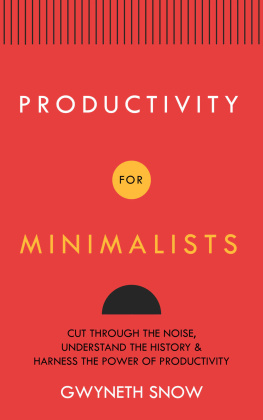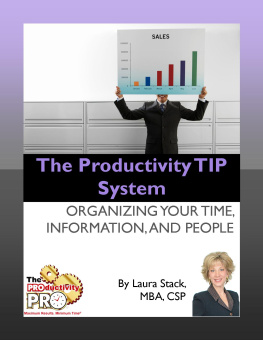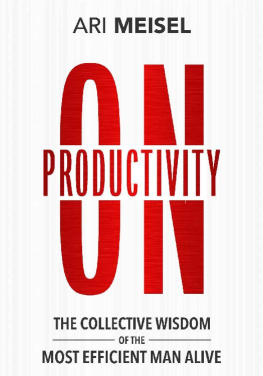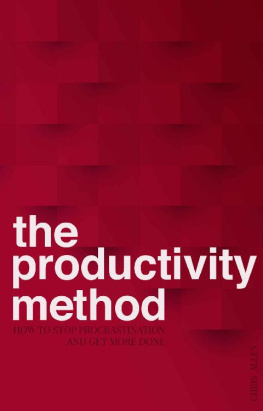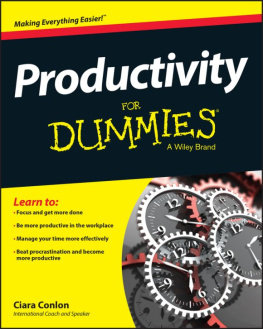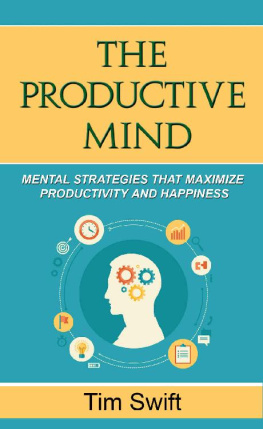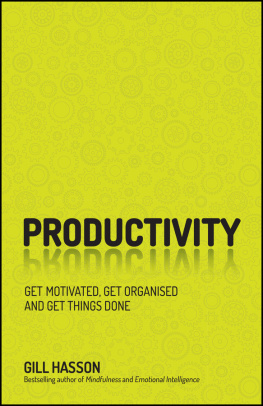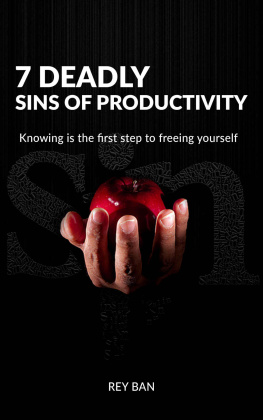Productivity for Minimalists
Cut Through the Noise, Understand the History & Harness the Power of Productivity
Gwyneth Snow
Copyright 2021 - All rights reserved.
It is not legal to reproduce, duplicate, or transmit any part of this document in either electronic means or in printed format. Recording of this publication is strictly prohibited and any storage of this document is not allowed unless with written permission from the publisher except for the use of brief quotations in a book review.
Table of Contents
Introduction
The secret of getting ahead is getting started. The secret of getting started is breaking your complex overwhelming tasks into small manageable tasks, and starting on the first one. Mark Twain
Being productive is difficult. And the concept of productivity enters into our lives in a myriad of ways. You wake up in the morning and wonder what youll do today. Do you feel overwhelmed by the long list of tasks you have? Is it difficult to remain focused on work? If so, you may need to approach the subject of productivity through the lenses of a minimalist.
In modern society, we are constantly bombarded by social media and television. News articles report on people who accomplish a great deal. Television portrays lifestyles that may not be attainable for the average person. Social media is filled with people who seem to be successful in accomplishing the hardest of goals. They push the idea that you, too, can do the same. Theres so much pressure to reach standards set by society. To do so, the media advises using complicated steps and resources. Often, those arent at all helpful, nor do they apply to your personal circumstances. So, what do we mean by approaching productivity with a minimalist viewpoint?
To minimize something is to reduce the unwanted or useless aspects. With less clutter, you have less to worry about. With fewer items surrounding you, there are fewer to organize. With the useless clutter eliminated from your life, you can find clarity. You can streamline your days, shorten your to-do lists, and increase your efficiency at work.
So, you may ask: what are the unwanted and useless aspects of productivity? Minimalism is often applied to household objects and decorating. This means you can think of the useless aspects of productivity like knick-knacks that you dislike but only keep out of politeness for whoever gave it to you. Another example could be a kitchen utensil that youve never used, but you believe you may need someday. This is not to judge what anyone owns, but to exemplify how productivity compares with minimalism. For productivity, the unnecessary decoration or utensil may be: an unhealthy work-life balance, the view and pressure of others, the influence of the media, not prioritizing properly, or toxic office culture. All of these are clutter that one may put up with for some reason or another.
How ironic that in this age of automation and convenience, we still struggle with productivity. In fact, certain innovations in technology have worsened this problem. Society has more information and resources than ever before, but you will soon see how it can cause the balance between work and home life to blur. The Industrial Revolutions push for convenience granted the world wonderful, life-saving inventions, but with new advancements come new problems. Later chapters will consider the growth of widespread productivity and the effects it has on society, commerce, and even our daily lives. We will consider how the abundance of resources and convenience have both benefited us and caused harm to others. Understanding the root of the problem will help you determine the reasons behind toxic workplace cultures that are so prevalent today.
First of all, when building a house, one must always start with the foundation. You will learn what productivity is, what it is not, and then you will move on to how it became a societal pressure and internet trend. After considering that information, a sobering glimpse into the beginnings of mass production will reveal the scars society still bears. Lastly, the minimalist viewpoint will be applied to your life in practical, easy-to-understand steps. Youll learn how to eliminate clutter and achieve your goals as stress-free as possible.
So, as Mark Twain said so succinctly, to get ahead, you must first get started.
Chapter One: What Is Productivity?
"Productivity is being able to do things that you were never able to do before." Franz Kafka, German Author
When taken literally, productivity is a measurement. In business and economics, it applies to the efficiency of a product or worker. The measurement is often the ratio of resources spent vs. the finished product.
However, youre not a product; youre someone who wishes to simplify your work routine in a healthy and fulfilling way. You dont want your list of tasks to grow longer; you want to shorten it. Consider the large part that productivity plays in your personal life.
Many people would define personal productivity as the completion of a task or energy exerted toward their goals. This is an instinctive feeling and part of human nature. We all desire to be productive, but make sure to meditate on what that word means to you personally.
For some, productivity may come in the form of cleaning a house, finishing a to-do list, or advancing a hobby. To someone else, productivity may be the number of hours their employees worked, or the quantity of an item produced. If youre an employee you may consider productivity to be a project well done or a days work drawing to a close. Every application is common, as the definition of productivity itself is versatile. Once you have defined your view, the next step is to reduce the noise surrounding the concept.
Minimize what productivity means to you into something more bite-sized. Does seeing the results of your work make you feel productive? If so, focus on each small step instead, rather than the larger picture. Although it is satisfying to see results, you can be productive in the process of working for those results as well. The process is just as important.
For example, you wouldnt tell someone at the gym that they arent productive only because they have not yet reached their fitness goal. This is because productivity comes from an understanding of why you must do this task, how to start and continue it, and what you can expect when you finish. Remember, productivity can be applied to both the process and the end goal.
Its common to organize this process in a to-do list. A to-do list is a familiar aspect of most homes and workplaces. It is considered to be vital when being productive because it provides much-needed structure. The resources for these lists are endless. There are phone apps, templates, websites, and blogs all available because its natural for us to desire organization in a way thats accessible. However, is the to-do list enough? Does the list truly motivate you? And when the list grows, do you feel overwhelmed by the number of tasks listed?
Youre not alone. Burying yourself beneath a mountain of constant chores can have negative mental health effects and social consequences and become the cause of familial conflicts. To circumvent this rising issue, the internet is filled with guides for productivity and anxiety management. Yet, are those guides truly helpful in resolving the root of the problem? Will the overwhelmed feeling go away so easily? The output you can produce is based on circumstance, the time you have available, and who you are as a person. Instead of researching tips that may not even work for you, its best to start at the root. Clear away any distractions and endless resources that are advertising themselves, then simplify your productivity and what that means for you.

